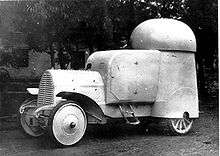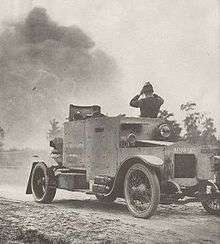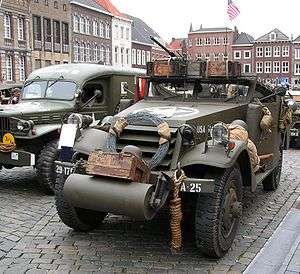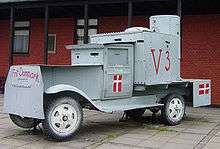Armored car (military)

A military armored (or armoured) car is a lightweight wheeled armored fighting vehicle, historically employed for reconnaissance, internal security, armed escort, and other subordinate battlefield tasks.[1] With the gradual decline of mounted cavalry, armored cars were developed for carrying out duties formerly assigned to horsemen.[2] Following the invention of the tank, the armored car remained popular due to its comparatively simplified maintenance and low production cost. It also found favor with several colonial armies as a cheaper weapon for use in underdeveloped regions.[3] During World War II, most armored cars were engineered for reconnaissance and passive observation, while others were devoted to communications tasks. Some equipped with heavier armament could even substitute for tracked combat vehicles in favorable conditions—such as pursuit or flanking maneuvers during the North African Campaign.[3]
Since World War II the traditional functions of the armored car have been occasionally combined with that of the armored personnel carrier, resulting in such multipurpose designs as the Cadillac Gage Commando.[2] Postwar advances in recoil control technology have also made it possible for a few armored cars, including the AMX-10RC and EE-9 Cascavel, to carry large cannon capable of threatening many tanks.[4]
History
Armed car

The Motor Scout was designed and built by British inventor F.R. Simms in 1898. It was the first armed petrol engine-powered vehicle ever built. The vehicle was a De Dion-Bouton quadricycle with a mounted Maxim machine gun on the front bar. An iron shield in front of the car protected the driver.[5]
Another early armed car was invented by Royal Page Davidson at Northwestern Military and Naval Academy in 1898 with the Davidson-Duryea gun carriage and the later Davidson Automobile Battery armored car.
However, these were not 'armored cars' as the term is understood today, as they provided little or no protection for their crews from enemy fire. They were also, by virtue of their small capacity engines, less efficient than the cavalry and horse-drawn guns that they were intended to complement.
First armored cars
At the beginning of the 20th century, the first military armored vehicles were manufactured, by adding armor and weapons to existing vehicles.

The first armored car was the Simms' Motor War Car, designed by F.R. Simms and built by Vickers, Sons & Maxim of Barrow on a special Coventry-built Daimler chassis[6] with a German-built Daimler motor in 1899.[6] and a single prototype was ordered in April 1899[6] The prototype was finished in 1902,[6] too late to be used during the Boer War.
The vehicle had Vickers armour 6 mm thick and was powered by a four-cylinder 3.3-litre[6] 16-hp Cannstatt Daimler engine, giving it a maximum speed around 9 miles per hour (14 kilometres per hour). The armament, consisting of two Maxim guns, was carried in two turrets with 360° traverse.[7][8] It had a crew of four. Simms' Motor War Car was presented at the Crystal Palace, London, in April 1902.[9]

Another early armored car of the period was the French Charron, Girardot et Voigt 1902, presented at the Salon de l'Automobile et du cycle in Brussels, on 8 March 1902.[10] The vehicle was equipped with a Hotchkiss machine gun, and with 7 mm armour for the gunner.[11][12]
One of the first operational armoured cars with four wheel (4x4) drive and fully enclosed rotating turret, was the Austro-Daimler Panzerwagen built by Austro-Daimler in 1904. It was armoured with 3-3.5 mm thick curved plates over the body (drive space and engine) and had a 4mm thick dome-shaped rotating turret that housed one or two machine-guns. It had a 4-cylinder 35 hp 4.4 litre engine giving it average cross country performance. Of note both the driver and co-driver had adjustable seats enabling them to raise them to see out of the roof of the drive compartment as needed.[13]

The Italians used armored cars during the Italo-Turkish War.[14] A great variety of armored cars appeared on both sides during World War I and these were used in various ways.
World War I
Generally, the armored cars were used by more or less independent car commanders. However, sometimes they were used in larger units up to squadron size. The cars were primarily armed with light machine guns, but larger units usually employed a few cars with heavier guns. As air power became a factor, armored cars offered a mobile platform for antiaircraft guns.[15]

The first effective use of an armored vehicle in combat was achieved by the Belgian Army in August–September 1914. They had placed Cockerill armour plating and a Hotchkiss machine gun on Minerva Armored Cars. Their successes in the early days of the war convinced the Belgian GHQ to create a Corps of Armoured Cars, who would be sent to fight on the Eastern front once the western front immobilized after the Battle of the Yser.[16][17][18]

The British Royal Naval Air Service dispatched aircraft to Dunkirk to defend the UK from Zeppelins. The officers' cars followed them and these began to be used to rescue downed reconnaissance pilots in the battle areas. They mounted machine guns on them[19] and as these excursions became increasingly dangerous, they improvised boiler plate armoring on the vehicles provided by a local shipbuilder. In London Murray Sueter ordered "fighting cars" based on Rolls-Royce, Talbot and Wolseley chassis. By the time Rolls-Royce Armoured Cars arrived in December 1914, the mobile period on the Western Front was already over.[20] As described below, they had a fascinating birth and long and interesting service.
More tactically important was the development of formed units of armored cars, such as the Canadian Automobile Machine Gun Brigade, which was the first fully mechanized unit in the history of the British Army. The brigade was established on September 2, 1914 in Ottawa, as Automobile Machine Gun Brigade No. 1 by Brigadier-General Raymond Brutinel. The Brigade was originally equipped with 8 armored Autocars mounting 2 machine guns. By 1918 Brutinel's force consisted of two Motor Machine Gun Brigades (each of five gun batteries containing eight weapons apiece).[21] The brigade, and its armored cars, provided yeoman service in many battles, notably at Amiens.[22]
The Rolls-Royce Armoured Car was famously proposed, developed, and utilised[23] by the 2nd Duke of Westminster. He took a squadron of these cars to France in time to make a noted contribution to the Second Battle of Ypres, and thereafter the cars with their master were sent to the Middle East to play a part in the British campaign in Palestine and elsewhere. These cars appear in the memoirs of numerous officers of the BEF during the earlier stages of the Great War - their ducal master often being described in an almost piratical style.
World War II

The British Royal Air Force (RAF) in the Middle East was equipped with Rolls-Royce Armoured Cars and Morris tenders. Some of these vehicles were among the last of a consignment of ex-Royal Navy armored cars that had been serving in the Middle East since 1915.[24] In September 1940 a section of the No. 2 Squadron RAF Regiment Company was detached to General Wavell’s ground forces during the first offensive against the Italians in Egypt. It is said that these armored cars became ‘the eyes and ears of Wavell’. During the actions in the October of that year the Company was employed on convoy escort tasks, airfield defense, fighting reconnaissance patrols and screening operations.

During the Anglo-Iraqi War, some of the units located in the British Mandate of Palestine[25] were sent to Iraq and drove Fordson armored cars.[26] "Fordson" armored cars were Rolls-Royce armored cars which received new chassis from a Fordson truck in Egypt.
Since the Treaty of Versailles did not mention armored cars, Germany began developing them early. By the start of the new war, the German army possessed some highly effective reconnaissance vehicles, such as the Schwerer Panzerspähwagen.
The Soviet BA-64 was influenced by a captured Leichter Panzerspähwagen before it was first tested in January 1942.
In the second half of the war, the American M8 Greyhound and the British Daimler Armoured Cars featured turrets mounting light guns (40 mm or less). As with other wartime armored cars, their reconnaissance roles emphasized greater speed and stealth than a tracked vehicle could provide, so their limited armor, armament and off-road capabilities were seen as acceptable compromises.
Military use

A military armored car is a type of armored fighting vehicle having wheels (from four to ten large, off-road wheels) instead of tracks, and usually light armor. Armored cars are typically less expensive and on roads have better speed and range than tracked military vehicles. They do however have less mobility as they have less off-road capabilities because of the higher ground pressure. They also have less obstacle climbing capabilities than tracked vehicles. Wheels are more vulnerable to enemy fire than tracks, they have a higher signature and in most cases less armor than comparable tracked vehicles. As a result, they are not intended for heavy fighting; their normal use is for reconnaissance, command, control, and communications, or for use against lightly armed insurgents or rioters. Only some are intended to enter close combat, often accompanying convoys to protect soft-skinned vehicles.
Light armored cars, such as the British Ferret are armed with just a machine gun. Heavier vehicles are armed with autocannon or a small tank gun. The heaviest armored cars, such as the German, World War II era SdKfz 234 or the modern, US M1128 Mobile Gun System, mount the same guns that arm medium tanks.

Armored cars are popular for peacekeeping or internal security duties. Their appearance is less confrontational and threatening than tanks, and their size and maneuverability is said to be more compatible with tight urban spaces designed for wheeled vehicles. However, they do have a larger turning radius compared to tracked vehicles which can turn on the spot and their tires are vulnerable and are less capable in climbing and crushing obstacles. Further, when there is true combat they are easily outgunned and lightly armored. The threatening appearance of a tank is often enough to keep an opponent from attacking, whereas a less threatening vehicle such as an armored car is more likely to be attacked.
Many modern forces now have their dedicated armored car designs, to exploit the advantages noted above. Examples would be the M1117 Armored Security Vehicle of the USA or Alvis Saladin of the post-World War II era in the United Kingdom.
Alternatively, civilian vehicles may be modified into improvised armored cars in ad hoc fashion. Many militias and irregular forces adapt civilian vehicles into AFVs (armored fighting vehicles) and troop carriers, and in some regional conflicts these "technicals" are the only combat vehicles present. On occasion, even the soldiers of national militaries are forced to adapt their civilian-type vehicles for combat use, often using improvised armor and scrounged weapons.
See also
.jpg)
- Armored bus
- Armored personnel carrier
- Armored car (VIP)
- Armoring:
- Gun truck
- Tankette
- Technical (vehicle)
Notes
- ↑ Lepage, Jean-Denis G.G. German Military Vehicles of World War II: An Illustrated Guide to Cars, Trucks, Half-Tracks, Motorcycles, Amphibious Vehicles and Others (2007 ed.). McFarland & Company. pp. 169–172. ISBN 978-0786428984.
- 1 2 Bull, Stephen. Encyclopedia of Military Technology and Innovation (2004 ed.). Greenwood Publishing Group. pp. 19–20. ISBN 978-1573565578.
- 1 2 Bradford, James. International Encyclopedia of Military History (2006 ed.). Routledge Books. pp. 97–98. ISBN 978-0415936613.
- ↑ Dougherty, Martin J. Modern Weapons: Compared and Contrasted: Armored Fighting Vehicles (2012 ed.). Rosen Central. pp. 34–36. ISBN 978-1448892440.
- ↑ Macksey, Kenneth (1980). The Guinness Book of Tank Facts and Feats. Guinness Superlatives Limited, ISBN 0-85112-204-3.
- 1 2 3 4 5 Edward John Barrington Douglas-Scott-Montagu Baron Montagu of Beaulieu; Lord Montagu; David Burgess Wise (1995). Daimler Century: The Full History of Britain's Oldest Car Maker. Haynes Publications. ISBN 978-1-85260-494-3.
- ↑ Macksey, Kenneth (1980). The Guinness Book of Tank Facts and Feats. Guinness Superlatives Limited. p. 256. ISBN 0-85112-204-3.
- ↑ Tucker, Spencer (1999). The European Powers in the First World War. Routledge. p. 816. ISBN 0-8153-3351-X.
- ↑ Armoured Fighting Vehicles of the World, Duncan, p.3
- ↑ Gougaud, Alain (1987). L'aube de la gloire: les autos mitrailleuses et les chars français pendant la Grande Guerre, histoire technique et militaire, arme blindée, cavalerie, chars, Musée des blindés. p. 11. ISBN 978-2-904255-02-1.
- ↑ Early Armoured Cars E. Bartholomew, p.4
- ↑ Gougaud, p.11-12
- ↑ http://www.tanks-encyclopedia.com/ww1/austria-hungary/Austro-Daimler_Panzerwagen.php
- ↑ Crow, Encyclopedia of Armored Cars, pg. 102
- ↑ Crow, Encyclopedia of Armored Cars, pg. 25
- ↑ http://www.philatelicdatabase.com/postal-history/wwi-belgium-armoured-car-division-in-russia/
- ↑ http://www.wio.ru/tank/for-rus.htm
- ↑ http://www.greatwardifferent.com/Great_War/Russia/Russia_00.htm
- ↑ Band of Brigands p 59
- ↑ First World War - Willmott, H.P., Dorling Kindersley, 2003, Pg. 59
- ↑ P. Griffith p 129 "Battle Tactics on the Western Front - The British Army's art of attack 1916–18 Yale university Press quoting the Official History 1918 vol.4, p42
- ↑ Cameron Pulsifer (2007). ' 'The Armoured Autocar in Canadian Service' ', Service Publications
- ↑ Verdin, Lt.-Col. Sir Richard (1971). The Cheshire (Earl of Chester's) Yeomanry. Birkenhead: Willmer Bros. Ltd. pp. 50–51.
- ↑ Lyman, Iraq 1941, pg. 40
- ↑ Lyman, p. 57
- ↑ Lyman, Iraq 1941, pg. 25
References
- Crow, Duncan, and Icks, Robert J., Encyclopedia of Armored Cars, Chatwell Books, Secaucus, NJ, 1976. ISBN 0-89009-058-0.
